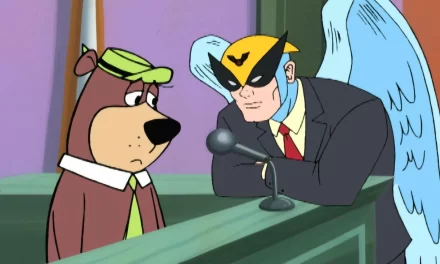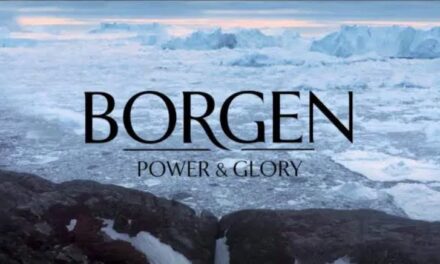
There have been few DVD box sets that I have enjoyed going through so much as volumes 2-4 of the Network Look-Back on 70’s Telly anthologies, which collectively run to 48 different half-hour shows, allowing the viewer investigate almost the full range of 1970s ITV children’s drama (Volume 1 is devoted to pre-school shows). They really do seem to have everything in them, the only omissions that I can find being anything made by Southern, The Tomorrow People (neither of which Network have the rights for) and The Georgian House. The compilation of a variety of different shows is a truly underused box set form, that I wish was attempted more often – the only other ones on my shelf are Network’s Soap Box and ITC Retro-Action blu-rays. They are user-friendly products, too. Watching a collection of individual episodes from different programmes (even disappointing ones) avoids that terrible, sinking, sensation of “I’ve paid £20 for this?” familiar to all speculative buyers of series of old TV drama, and allows you to watch many programmes that you would never otherwise get around to seeing. Or even get to see at all – some of the very best of the dramas on Look-Back have yet to be released.
A very few non-drama shows are scattered amongst the set. Even as a child who was always ecstatically delighted to see The Goodies or Sykes, I never responded very positively to the option of “children’s comedy”, and nothing here has caused me to change my mind. Of greater interest are the magazine and quiz programmes, especially the compelling Anything You Can Do (Granada), which demonstrates the very different expectations what a fun inter-schools competition of 1974 should consist of. Where, by the late 1980s, such programmes mostly seemed to consist of children throwing gunge at each other, in the more testing 1970s contestants were marked on their recitations of speeches from George Bernard Shaw’s Saint Joan.
As a historian of television drama (this being me, I only watched after collating a list that enabled me to view all 48 shows in chronological order) with a particular interest in ITV and the 1970s, the Look-Back anthologies create a unique opportunity to identify trends, tendencies and developments in children’s drama over the decade. So I thought that I’d share a few of my reflections with you – in particular, what the collection suggests about what the different house styles and concerns were of the various producing ITV companies:
“Gritty” Social realism
In essence you get two concurrent trends in these dramas – socially conscious realism and mythic fantasy (often realised in the form of ghosts, dreams, ancient sites and so forth). What’s striking about the social realism for this 1980s child is its occasional matter-of-fact presentation of irresponsible and criminal acts, that give you a good sense of how to break the law, and doesn’t seem to serve as a prescriptive site for investigating “issues”.
Such jarring moments include; learning how to break into a car and hotwire it (A Place to Hide, ATV, 1976); a gang of cosh- and chain-wielding yobs attacking an immigrant boy, who is then protected by a schoolboy hero who smokes and pinches milk from floats, before the pair are drawn into a murder threat (Soldier & Me, Granada, 1974); a youth almost drowned by a madman who then inveigles his way into his house and starts to mess with his mind (The Intruder, Granada, 1972, closer to Pinter than any family fare); and, most impressive of all, ATV’s The Siege of Golden Hill (1975) in which a street gang smash up a youth club and threaten a girl in front of her impotent father, before a second act after the commercial break of an elderly tenant being intimidated out of his home. There appears to have been a logistical scheduling problem with these shows, in that they were programmes intended for teenagers, but broadcast in a primary school-friendly slot.
One of the things that I admire in this trend is the sense of progressive programme-makers creating shows that encouraged teenagers to critique and engage with the power structures of their lives and the institutions that dominate them, such as the Golden Hill youth club, and particularly the samizdat fifth form underground school magazine of ATV’s concurrent A Bunch of Fives (1977).
Although I identify the two dominant trends as being the social realist and the telefantastical, they cannot be seen as binary oppositions, often working in parallel, perhaps most distinctively in Bob Baker and Dave Martin’s King of the Castle (HTV, 1977) in which tower block urban nightmare is all realized in 16mm and wild dungeon fantasy is all studio videotape with doubling of actors drawing a parallel between the two worlds.
ATV
This parallel realist/fantastical drama can be seen most especially in programmes from ATV, the major discovery for me, personally, when watching these discs. I think that my favourite programme of all has been Come Back, Lucy (1978). Ghost stories were perhaps the most frequent form of children’s drama in this period, but this one struck me as the most developed, in managing to do three things simultaneously; make the orphaned, old-fashioned, private Lucy an empathetic figure; make her modern foster family funny in a satirical way, yet still retain the viewer’s sympathy; and make the (quite sparingly-established) ghost story frightening. Similarly exciting is Escape Into Night (1972), adapted from Catherine Storr’s novel Marianne Dreams, where a young girl’s drawings become dreams and the diving line between dreams and reality blurs. The dramatic and visual presentation of this drama about a dream and real state is notably sophisticated.
One of the great in-house strengths of the ATV shows was their ability to create complex serial narratives that never condescended to their audience. This is particularly evident in the conspiracy thrillers Tightrope (1972), The Jensen Code (1973) and Fly Into Danger (1972). Its a pretty odd genre to try to achieve for children, but all three do a good job of establishing their protagonists and their worlds. I will be interested to investigate further and discover how the first two extend their narratives over 13 episodes. When seen in comparison with Tyne Tees’ Quest for Eagles (1979), a convoluted attempt to do a Le Carre narrative for youngsters, you realise just how well-judged these ATV series were.
Although there is one exception to this run of quality, in the real shocker that is Timeslip (1970). For over 25 years, ever since I first read about it in a copy of Time Screen magazine I bought in Forbidden Planet, I had been led to believe that it was some kind of telefantasy classic, which it certainly wasn’t on the evidence presented here. The acting is in the same odd register that you also find on Crossroads and General Hospital. As in the possession storylines of many 1970s children’s telefantasy series, something uncanny happened to performers when they signed on for a job at ATV…
HTV
Thanks in particular to Children of the Stones (1976) (the one ITV children’s drama to have passed into the TV drama canon) HTV have developed something of a reputation as the connoisseur’s choice for ITV children’s drama, but the full range of their projects comes across as a bit hit-and-miss forty years on, despite the evident care that goes into every production. The flaws and charms of Bob Baker & Dave Martin’s approach to drama found in Doctor Who and in their police shows (Target) – i.e. throw together a lot of crazy ideas and hope for the best – wasn’t toned down when they wrote for children. I found that the non-fantasy Follow Me (in which a boy and his father try to rescue a kidnapped girl) worked rather better than their other two series here (King of the Castle and Sky, 1975), as well as being particularly good on making imaginative and dramatic use of Bristol, as one might expect.
Thames
Thames’s house style was more evident in the evident expense and quality of design that went into each production, especially the Ancient Britain stories Warrior Queen (1978, Boudicca) and The Boy Merlin (1979), rather than any particular overarching approach to the work. The real standout for me is the Aztec dynasty drama The Feathered Serpent (1976) which is realized like a children’s I, Claudius. Contemporaneous articles from Look-In reveal that the winner of a “design-a-costume” competition had their entry specially made for the programme in Milan. Top that, HBO!
Yorkshire
The four Yorkshire productions – Tom Grattan’s War (1968), Follyfoot (1971), The Flaxton Boys (1970) and Boy Dominic (1974) – were the other major discovery for me in the collection. What went on with the company’s children’s dramas very much chimes with the early years of their drama department as a whole. Because Yorkshire were the only one of the big five companies that emerged from the 1968 ITV franchise shake-up that had to start from scratch, I always get the impression that they really had to fight to develop a distinctive voice and to make it heard nationally. So for the first stage of their existence (up to about 1976 or so) almost every drama that they made (Gazette, Hadleigh, The Main Chance, Parkin’s Patch, Justice, Emmerdale Farm, South Riding) was explicitly Yorkshire-based and feels very much to be a part of the same distinct house style.
LWT
Because they were unable to broadcast their shows in the usual weekday children’s slots, London Weekend Television approached children’s TV from a different angle to the other companies, working towards a general family audience in Catweazle (1970) and The Adventures of Black Beauty (1973). The one thing that really struck me in their productions though, was what an astonishingly assured comic performance the 12-year old Bonnie Langford gives as Violet Elizabeth Bott in Just William (1977). You can see why this has, perhaps unfairly, coloured everybody’s subsequent impressions of her for the last 38 years.

Coming to the end of the Look-Back collection, it was hard not to feel an elegiac sense of loss for some of the broadcasting conditions of 1970s ITV. Missing the familiar idents and regional identifications of the old ITV companies is partly the product of a muzzy middle-aged nostalgia on my part, of course, but then again… The old system did hold some advantages for young viewers who grew up with it, meaning that we could identify a range of a dozen or so companies who made the programmes we watched, and learned to recognize through their idents what sort of shows we might expect to follow, even what part of the country we might see depicted in them.
Missing children’s television in the mainstream schedules of ITV and BBC1 is less easy to dismiss as nostalgic thinking. Children’s drama is now pretty much an obsolete form in Britain (it has been suggested that last year’s series of Wizards vs Aliens for the BBC will be the final children’s drama produced). But just over forty years ago, it was a regular occurrence for ITV’s children’s dramas to break into the top 20 ratings, their pre-news/Crossroads timeslot swelling the audience with parents and relatives. When I think of the dramatically sophisticated, uncondescending and non-prescriptive, stories told in many of the dramas in the Look-Back collections, and I reflect that they would have been seen and discussed by children and parents together, and watched by many others at the same time, the broadcasting conditions of the 1970s feel like they worked as an influence for some good, positive, ends.
Billy Smart is Research Officer at the AHRC-funded ‘Forgotten British Television drama: 1946-1982’ project at Royal Holloway.





